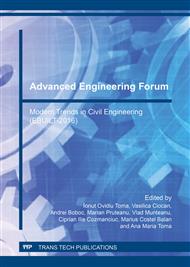p.207
p.213
p.219
p.226
p.234
p.242
p.249
p.255
p.262
Numerical Analysis of GFRP Interposed Lamella Effect on the Structural Behavior of Timber Beams
Abstract:
The use of numerical methods to simulate materials or civil structures behavior is an efficient tool to predict their performance in diverse specific applications and design situations. The authors propose a set of numerical parameters able to describe the effect of the two interposed GFRP lamellae on a structural member composed of three wood battens connected lengthwise with mechanical fasteners, further considered as the reference beam. The numerical simulation is carried out in several steps. Firstly, the numerical model is calibrated with the experimental test of the reference beam. Secondly, the two GFRP lamellae are introduced between the timber members and the stress state and deformations both in cross-section`s components and at their interface are examined. The material models used in simulations were chosen according to the type of efforts that occur in timber beams and their failure modes when subjected to bending. For the timber components an orthotropic material model was considered. For the GFRP components linear elastic until failure material model was introduced. The interfaces between timber/GFRP lamellae were modeled by using cohesive zone material model with separation-distance based debonding. The results show a good correlation with those experimentally obtained and the parameters provided by this numerical analysis may be reliably used for specific design situations.
Info:
Periodical:
Pages:
234-241
Citation:
Online since:
March 2017
Price:
Сopyright:
© 2017 Trans Tech Publications Ltd. All Rights Reserved
Share:
Citation:


